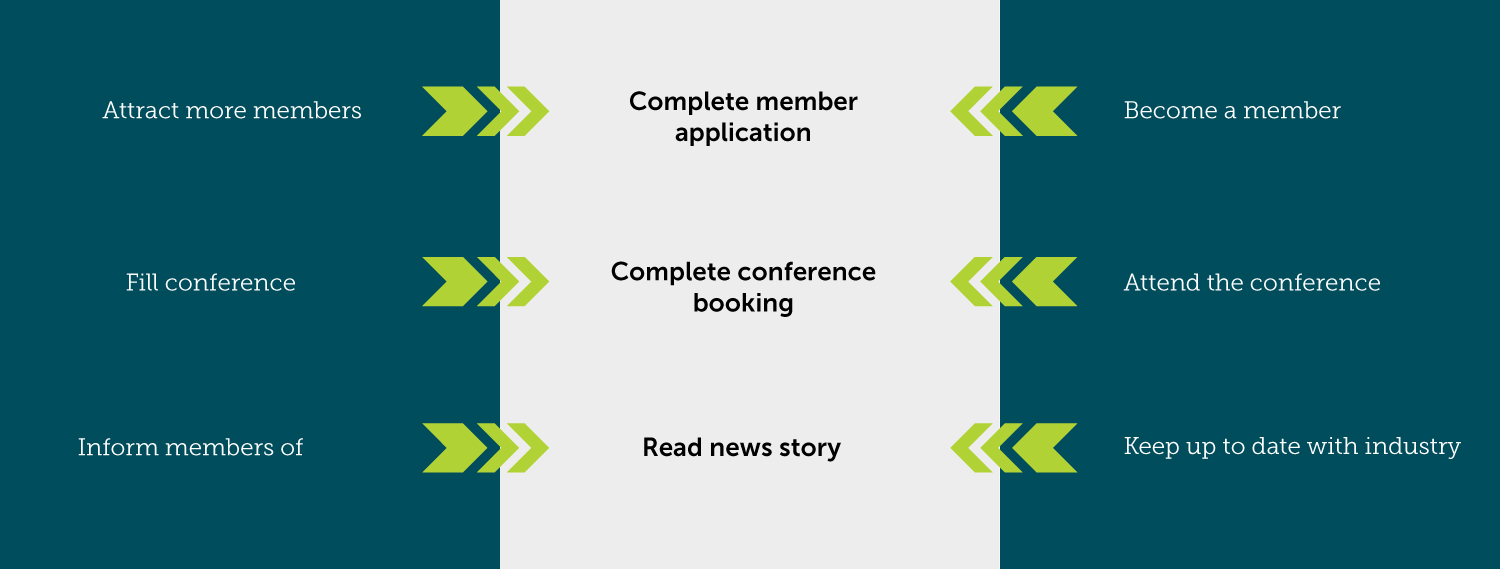Goals?
One of the more important aspects to think about when designing or changing your membership website is the goal (or goals) of the website. As we’ll explore, it can positively influence your design decisions and also help you further understand the effectiveness of your marketing campaigns.
Setting goals
Think of a goal as the reason your website exists. You can view this from your point of view - as someone who is in charge of the website. Also, you can think of it in terms of different personas that might visit your website. They are usually the endpoints of key website journeys.
The goals from your own point of view should come from the aims of your organisation. An example might be “to attract more members” for instance. This would translate to someone completing an application on your website. A goal of a visitor might be “to book an event” which translates to a user completing an event booking on the website.
Before delving further into goals, it is important to check that the goals of your membership association align with the end user’s goals on the website itself, like so:

The above example has 3 goals that align the organisation and the end user. The goals are all points that can be measured on the website itself which makes things simpler. If the goals of the organisation clash or misalign with the audience then the website or goals might need to be reconsidered - as the website is not offering what the user needs.
Using goals – (1) Marketing effectiveness
Once you know your goals, they can be coded into a website stats package (such as Google Analytics) and as such you can see, amongst other things, the how many people “convert” – meaning how many times goals are hit. Assuming you can segment your marketing campaign data in Analytics, then this stat can be used to measure how effective certain marketing campaigns have been. It empowers your marketing team to make better decisions and to give accurate reporting on campaigns instead of subjective opinions.
For instance, if an email campaign goes out to your members about your conference, you can see how effective it was by how many people booked your conference. You also then have a benchmark against future campaigns. The more marketing you do against certain goals, the better the idea you’ll have of which marketing campaigns have worked better. This allows you to do more of the good campaigns and/or improve the bad ones, learning all the time.
Using goals – (2) Design and UX decisions
This works especially when making changes to an already existing website. If the rate at which people convert (usually a percentage) is lower than you might expect for a certain goal, then the relevant sections of your website might need improving.
Goals are a great tool for design and UX decisions as they can quantify whether ideas for improvement have worked. For instance, if there is a worry over a lack of conference bookings, you could change the position of the “book now” button and see if that improves your conversion rate. Setting goals allows you to incrementally improve your website and to test out your ideas.
Bonus feature – Funnels
Once you know your goals and have them set up so you can measure them, it allows you to delve into “funnels” – which are often the key stepping stones in the journey towards the end goal. So, to use the conference booking goal as an example, the goal is to complete the booking. But that is not the whole story. Other steps towards this goal are likely to be something along these lines:
- View the conference page
- Get to the booking screen
- Get to the checkout
- Complete the booking
Steps 1, 2 and 3 are therefore your funnel steps. Adding them into your stats package allows you to then be able to spot issues and opportunities. As well as knowing that your conversion rate is, say 4% for example, you can see data like:
- 20% go from step 1 to step 2
- Of those, 50% get to step 3
- Of those, 40% get to step 4, the end goal.
So you can learn the effectiveness of each step in the funnel and aim to improve the steps you think are underperforming. Or you could use aspects of the well-performing steps in areas of the website that trigger other goals if relevant.
Final thoughts
Setting goals is extremely useful, arguably necessary, to measure the success and failures of your website. Without goals, you have no idea how well your association's website is performing against your targets. Both design and marketing can benefit from the understanding goals give you about your website. However, when setting website goals, ensure that they meet the needs of your organisation and the needs of your audience.
If your organisation doesn’t have any goals or you’re not happy with the number of people joining or booking events on your website, then we can help. We specialise in membership association websites and focus our design build and marketing decisions around your goals. We would be happy to chat about our website services – feel free to get in touch.